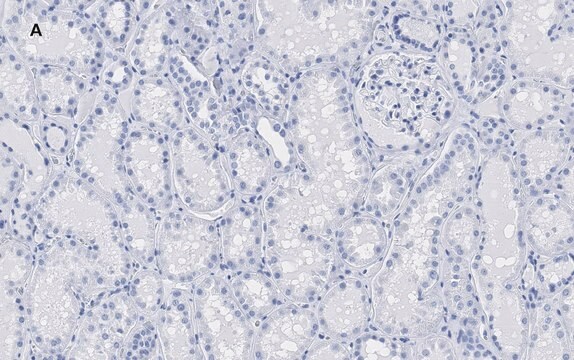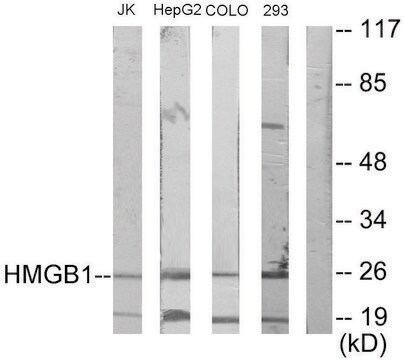H9539
Anti-HMGB1 (HMG1) (C-terminal) antibody produced in rabbit

affinity isolated antibody, buffered aqueous solution
Sinónimos:
Anti-Amphoterin, Anti-High mobility group box 1, Anti-High mobility group protein 1
About This Item
Productos recomendados
biological source
rabbit
conjugate
unconjugated
antibody form
affinity isolated antibody
antibody product type
primary antibodies
clone
polyclonal
form
buffered aqueous solution
mol wt
antigen 25 kDa
species reactivity
rat, mouse, human
packaging
antibody small pack of 25 μL
enhanced validation
independent
Learn more about Antibody Enhanced Validation
technique(s)
immunoprecipitation (IP): 5-10 μg using HEK-293T cell lysates.
indirect immunofluorescence: suitable
western blot: 0.5-1 μg/mL using 3T3 or PC12 cell lysates.
UniProt accession no.
shipped in
dry ice
storage temp.
−20°C
target post-translational modification
unmodified
Gene Information
human ... HMGB1(3146)
mouse ... Hmgb1(15289)
rat ... Hmgb1(25459)
General description
Immunogen
Application
Biochem/physiol Actions
Physical form
Storage and Stability
For extended storage, freeze in working aliquots.
Repeated freezing and thawing, or storage in “frostfree” freezers, is not recommended. If slight turbidity occurs upon prolonged storage, clarify the solution by centrifugation before use. Working dilutions should be discarded if not used within 12 hours.
Other Notes
Disclaimer
¿No encuentra el producto adecuado?
Pruebe nuestro Herramienta de selección de productos.
Related product
Storage Class
12 - Non Combustible Liquids
wgk_germany
nwg
flash_point_f
Not applicable
flash_point_c
Not applicable
ppe
Eyeshields, Gloves, multi-purpose combination respirator cartridge (US)
Elija entre una de las versiones más recientes:
¿Ya tiene este producto?
Encuentre la documentación para los productos que ha comprado recientemente en la Biblioteca de documentos.
in vitro function and clinical outcomes in vaccinated melanoma
patients
Nuestro equipo de científicos tiene experiencia en todas las áreas de investigación: Ciencias de la vida, Ciencia de los materiales, Síntesis química, Cromatografía, Analítica y muchas otras.
Póngase en contacto con el Servicio técnico







